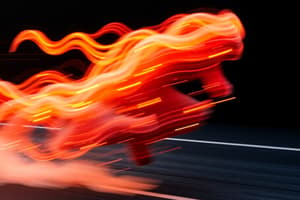Podcast
Questions and Answers
Define motion.
Define motion.
Change of position over time (e.g. speed)
Distance is the __________ traveled by an object.
Distance is the __________ traveled by an object.
change
What does a steeper graph in distance-time graph indicate?
What does a steeper graph in distance-time graph indicate?
Faster
What is the name of the force that opposes motion?
What is the name of the force that opposes motion?
What is the main function of the cornea in the human eye?
What is the main function of the cornea in the human eye?
Friction is directly proportional to the speed of moving objects. (True/False)
Friction is directly proportional to the speed of moving objects. (True/False)
The __________ contains light receptors called cones for clear vision.
The __________ contains light receptors called cones for clear vision.
Match the following parts of the eye with their functions:
Match the following parts of the eye with their functions:
The distance ____________ muscles work to change the thickness of the lens.
The distance ____________ muscles work to change the thickness of the lens.
What is the function of the pupil?
What is the function of the pupil?
What is the function of the iris?
What is the function of the iris?
Match the following eye defects with their effects:
Match the following eye defects with their effects:
Sound travels through vacuum.
Sound travels through vacuum.
What is the product when metal reacts with acids?
What is the product when metal reacts with acids?
What is the application of toothpaste?
What is the application of toothpaste?
Corrosive/toxic gases are released when mixing certain cleaners.
Corrosive/toxic gases are released when mixing certain cleaners.
Acid rain can corrode metal structures and ____________.
Acid rain can corrode metal structures and ____________.
Chemicals in food dissolve in the ______ inside our mouth.
Chemicals in food dissolve in the ______ inside our mouth.
Which of the following are the 5 primary tastes? (Select all that apply)
Which of the following are the 5 primary tastes? (Select all that apply)
What is the equation that combines taste and smell to create flavor?
What is the equation that combines taste and smell to create flavor?
Match the skin receptors with their functions:
Match the skin receptors with their functions:
Sweating helps cool down the body while shivering generates heat.
Sweating helps cool down the body while shivering generates heat.
What part of the brain controls memory and thinking?
What part of the brain controls memory and thinking?
What are some harmful effects of addiction as mentioned in the content?
What are some harmful effects of addiction as mentioned in the content?
Which of the following are suggestions for safety precautions when using acids and alkalis in the lab?
Which of the following are suggestions for safety precautions when using acids and alkalis in the lab?
Acid can be identified using blue litmus paper.
Acid can be identified using blue litmus paper.
Neutralization is the process where acid and alkali cancel out each other's properties, resulting in a ______ solution.
Neutralization is the process where acid and alkali cancel out each other's properties, resulting in a ______ solution.
Flashcards are hidden until you start studying
Study Notes
Chapter 11: Force & Motion
- Motion is a change in position over time, measured by distance (m) and speed (m/s)
- Distance-time graph represents motion, with steeper lines indicating faster speeds
- Initial distance and end distance are measured, with uniform motion showing a straight line
- Non-uniform motion shows a curved line, with acceleration and deceleration
Force & Motion
- Force (N) causes a change in speed or direction
- Forces can be contact (push, pull, friction, air resistance) or non-contact (gravity, magnetic, electrostatic)
- Unbalanced forces result in motion, while balanced forces result in no motion
- Spring balance measures force, and free-body diagrams show forces acting on an object
Gravity
- Gravity is a force that pulls objects towards each other, with the Earth's gravity pulling objects towards its center
- Gravity affects objects with mass, regardless of their size or shape
- Weight is the force of gravity acting on an object, with mass remaining constant regardless of location
- Friction opposes motion, and air resistance slows down objects moving through the air
Friction
- Friction occurs when two surfaces come into contact, opposing motion
- Ways to reduce friction include using rollers, ball bearings, air cushions, and lubricants
- Material surfaces, such as rubber or glass, can also reduce friction
Action & Reaction
- Action and reaction forces are equal and opposite, with one object exerting a force on another object
- Action and reaction forces are of the same type, with contact and non-contact forces possible
- Drawing action and reaction forces can help illustrate the concept
Chapter 10: Sensing the Environment
-
Sense organs, such as eyes, contain sensory cells or receptors that respond to stimuli
-
Stimuli trigger signals that are transmitted to the brain
-
The eye is a sense organ that responds to light, with the following structures:
- Cornea: allows light to enter
- Sclera: protects the eyeball's shape
- Retina: contains light receptors
- Optic nerve: carries signals from light receptors to the brain
- Lens: focuses light
- Blind spot: area where light receptors are absent, but no signal is sent### Eye Structure and Function
-
The eye has a lens that changes thickness to focus on near or far objects, and a pupil that controls the amount of light entering the eye.
-
The lens contracts to thicken for near vision and relaxes to thin for far vision.
-
The pupil is small in bright light to protect the eye from damage and large in dim light to allow more light to enter.
Light Receptor Cells
- There are two types of light receptor cells: cones and rods.
- Cones are responsible for color detection and work well in bright light, while rods work well in dim light but can't detect colors.
- The retina has a mostly yellow spot with cones and rods scattered throughout.
Eye Defects and Effects
- Shortsightedness: can't see far objects clearly due to a lens that is too thick or an eyeball that is too long.
- Longsightedness: can't see near objects clearly due to a lens that is too thin or an eyeball that is too short.
- Cataract: blurred vision due to age, long exposure to sunlight, or diabetes, and can be treated with artificial lens replacement.
- Astigmatism: can be treated with glasses or contact lenses.
- Color-blindness: inability to distinguish colors due to defects or absence of cones.
Eye Care Tips
- Maintain good posture and proper lighting when reading or using electronic devices.
- Keep a safe reading distance and use a clean towel to wash your face.
- Regular eye checks can help correct eye defects.
- Wear hats and sunglasses with UV protection to prevent strong light from damaging the eyes.
- Rest your eyes after reading or using electronic devices by looking at distant objects.
Hearing and Sound
- Sound is produced by the vibration of objects, which compresses air particles.
- Loudness is measured in decibels (dB), with higher amplitudes resulting in louder sounds.
- Pitch is determined by the frequency of sound waves, with higher frequencies resulting in higher-pitched sounds.
- Vocal cords in the throat produce sound when air is forced out through a slit.
Sound Travel
- Sound can travel through solid, gas, and liquid mediums, but not in a vacuum.
- Bionic ears can be treated with cochlear implants that transmit signals to the auditory nerve.
Ear Structure and Function
- The pinna collects sound waves and directs them into the ear canal.
- The eardrum vibrates from sound waves, transmitting signals to the brain.
- The cochlea is responsible for interpreting sound signals.
Hearing Loss and Noise Pollution
- Unpleasant or harmful sounds can lead to noise pollution and hearing loss.
- Noises above 85dB can cause permanent hearing loss, while long-term exposure to noises above 75dB can cause hearing loss.
Ear Care Tips
- Listen to music on earphones at no more than 60% of the maximum volume.
- Wear ear protectors in places with loud noises.
- Rest your ears after exposure to loud noises.
- See a doctor for a hearing check if you have signs of hearing loss.
Smell and Taste
-
Smell receptors are stimulated by chemicals in the air, which are carried into the nose and dissolved in a moist layer.
-
Smell receptors produce signals that are carried to the brain to be interpreted.
-
Taste receptors are located on the tongue and are stimulated by chemicals in food that dissolve in saliva.
-
Taste receptors produce signals that are carried to the brain to be interpreted.### Sense Organs
-
The mouth has taste receptors on taste buds that are stimulated by dissolved chemicals, sending signals to the brain to be interpreted.
-
There are 5 primary tastes: sweet, sour, salty, bitter, and umami.
-
Chemicals in food can travel through the air into the nose when chewed, contributing to the sense of flavor.
-
The skin has 5 kinds of receptors: pressure, heat, cold, pain, and touch, which are stimulated when in contact with a stimulus.
Brain Functions
- The brain receives signals from sensory receptors and interprets them to produce a response.
- The cerebrum controls the right body, learns, and memorizes.
- The cerebellum coordinates muscles, interprets signals, and understands movement.
- The medulla helps the body maintain balance, controls heartbeat, and breathing.
Addiction and Harmful Effects
- Drugs can harm our health by affecting sensory function and brain damage.
- Addictive substances can cause permanent damage to the heart, lungs, liver, and kidneys.
- Harmful effects include sores on the skin, addiction, hallucinations, loss of body control, and slow reaction.
- Frequent and painful urination, blurred vision, and permanent damage to the heart, lungs, liver, and kidneys are also possible.
Acids and Alkalis
- Acids are sour, corrosive, and can irritate the skin, while alkalines are bitter and slippery.
- Examples of acids include hydrochloric acid, nitric acid, and citric acid, while alkalines include sodium and potassium hydroxides.
- Safety precautions when using acids and alkalis in the lab include reading hazard labels, wearing safety goggles, wearing protective gloves, and avoiding direct contact.
Indicator and pH Meter
- Natural indicators like red cabbage, red carnation, and onion skin can be used to identify acidic or alkaline substances.
- Litmus paper and pH paper can also be used to test for acidity or alkalinity.
- Universal indicators can show the acidity or alkalinity of a solution.
- pH meters and pH sensors can provide precise measurements of pH levels.
Neutralization
- Acids and alkalis can be mixed together to cancel out their properties, resulting in neutralization.
- The pH curve can be used to determine the point of neutralization.
- Heat is released during neutralization, and the pH of the resulting solution is dependent on the volume of the reactants.
Applications
- Acid and alkali can be used to treat various conditions, such as tooth decay, wasp stings, and stomachaches.
- Industrial waste can be treated using acid and alkali.
- Acid and alkali can be used to clean surfaces and remove stains.
- Acid and alkali can corrode materials, but this can be prevented using protective coatings.
Studying That Suits You
Use AI to generate personalized quizzes and flashcards to suit your learning preferences.




